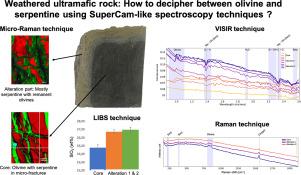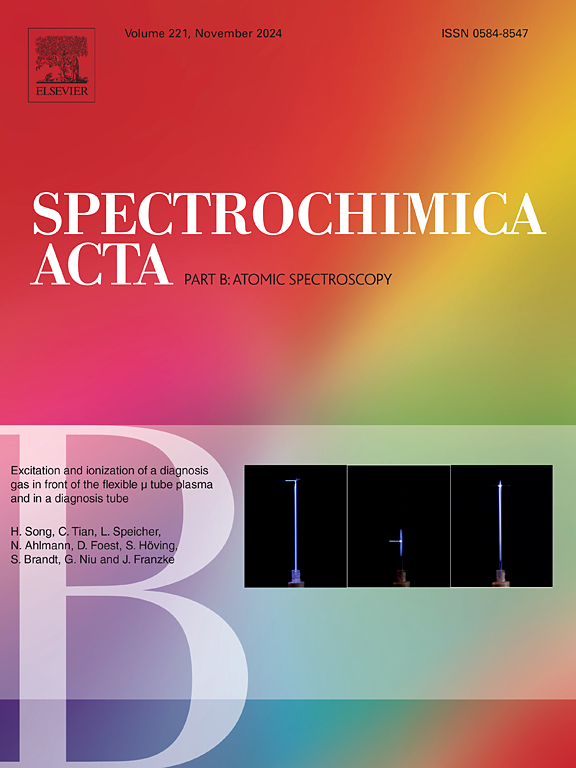变风化超镁铁质岩石:用类似超级照相机的技术研究它们的矿物学
IF 3.8
2区 化学
Q1 SPECTROSCOPY
引用次数: 0
摘要
自2021年2月以来,美国宇航局的毅力号火星车一直在探索火星上的耶泽洛陨石坑。来自Nili Fossae和Jezero陨石坑的轨道数据显示了广泛的矿物学特征,包括橄榄石等原生矿物,以及粘土和蛇形岩等多种次生矿物,以及轨道上最强烈的碳酸盐光谱特征之一。这个含橄榄石和碳酸盐岩的单元在区域上很广泛。大多数研究将橄榄石和含碳酸盐单元之间的关系解释为涉及蛇纹石化和碳酸化等流体-岩石相互作用的风化过程的结果。自2021年2月以来,Perseverance公司已经证实了原生和次生矿物的巨大多样性。蛇纹岩的探测是特别有趣的,以便更好地约束耶泽洛陨石坑过去的环境。在科学有效载荷中,SuperCam结合了三种光谱技术(激光诱导击穿光谱- LIBS,拉曼,可见光和近红外- VISIR),可以获得目标的元素组成,也可以获得它们的矿物和分子结构。在这里,我们使用了不同程度蚀变的陆地超镁铁质岩石,这些岩石在以前的研究中得到了很好的表征,我们使用SuperCam复制实验室设置对它们进行分析,以研究SuperCam检测橄榄石和次生相,特别是蛇纹岩的灵敏度。由于蛇纹石和橄榄石具有相似的化学性质,因此用LIBS区分它们是具有挑战性的。另一方面,当它们的含量足够高时,拉曼光谱能够检测到被分析样品中存在的所有相。最后,VISIR技术检测到橄榄石的二次相,但不容易观察到橄榄石。我们发现这三种技术之间的协同作用对于区分这些特定相特别重要,这些相在自然目标中作为复杂的混合物出现到亚微米尺度。本文章由计算机程序翻译,如有差异,请以英文原文为准。

Variably weathered ultramafic rocks: Investigation of their mineralogy with SuperCam-like techniques
The NASA Perseverance rover is exploring Jezero crater on Mars since February 2021. Orbital data from Nili Fossae and Jezero crater show a wide diversity of mineralogical signatures including primary mineral like olivine as well as diverse secondary minerals like clays and serpentines and one of the strongest spectral signatures of carbonate on Mars from orbit. This olivine and carbonate-bearing unit is regionally extensive. Most of the studies interpreted the relationship between olivine and carbonate-bearing units as a result of weathering processes involving fluid–rock interactions such as serpentinization and carbonation. Since February 2021, Perseverance has confirmed this large diversity of primary and secondary minerals. The detection of serpentine is of particular interest in order to better constrain the past environment at Jezero crater. Among the science payload, SuperCam is combining three spectral techniques (Laser-Induced Breakdown Spectroscopy - LIBS, Raman, and Visible and near InfraRed - VISIR) that give access to the elemental composition of the targets but also to their mineral and molecular structure. Here, we use terrestrial ultramafic rocks with various degrees of alteration that were well characterized from previous studies, and we analyze them with SuperCam replicate laboratory setups to investigate the sensitivity of SuperCam to detect olivine and secondary phases, in particular serpentines. Distinguishing serpentine from olivine by LIBS is challenging since they have similar chemistry. On the other hand, Raman spectroscopy is able to detect all the phases present in the analyzed samples, when their content is high enough. Finally, the VISIR technique detected the secondary phases while it did not observe easily the olivine. We found that the synergy between these three techniques is of particular importance to differentiate such specific phases, which occur as intricate mixtures down to the sub-micrometer scale in natural targets.
求助全文
通过发布文献求助,成功后即可免费获取论文全文。
去求助
来源期刊
CiteScore
6.10
自引率
12.10%
发文量
173
审稿时长
81 days
期刊介绍:
Spectrochimica Acta Part B: Atomic Spectroscopy, is intended for the rapid publication of both original work and reviews in the following fields:
Atomic Emission (AES), Atomic Absorption (AAS) and Atomic Fluorescence (AFS) spectroscopy;
Mass Spectrometry (MS) for inorganic analysis covering Spark Source (SS-MS), Inductively Coupled Plasma (ICP-MS), Glow Discharge (GD-MS), and Secondary Ion Mass Spectrometry (SIMS).
Laser induced atomic spectroscopy for inorganic analysis, including non-linear optical laser spectroscopy, covering Laser Enhanced Ionization (LEI), Laser Induced Fluorescence (LIF), Resonance Ionization Spectroscopy (RIS) and Resonance Ionization Mass Spectrometry (RIMS); Laser Induced Breakdown Spectroscopy (LIBS); Cavity Ringdown Spectroscopy (CRDS), Laser Ablation Inductively Coupled Plasma Atomic Emission Spectroscopy (LA-ICP-AES) and Laser Ablation Inductively Coupled Plasma Mass Spectrometry (LA-ICP-MS).
X-ray spectrometry, X-ray Optics and Microanalysis, including X-ray fluorescence spectrometry (XRF) and related techniques, in particular Total-reflection X-ray Fluorescence Spectrometry (TXRF), and Synchrotron Radiation-excited Total reflection XRF (SR-TXRF).
Manuscripts dealing with (i) fundamentals, (ii) methodology development, (iii)instrumentation, and (iv) applications, can be submitted for publication.

 求助内容:
求助内容: 应助结果提醒方式:
应助结果提醒方式:


